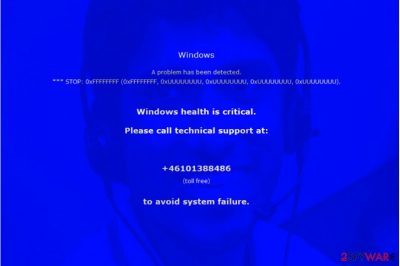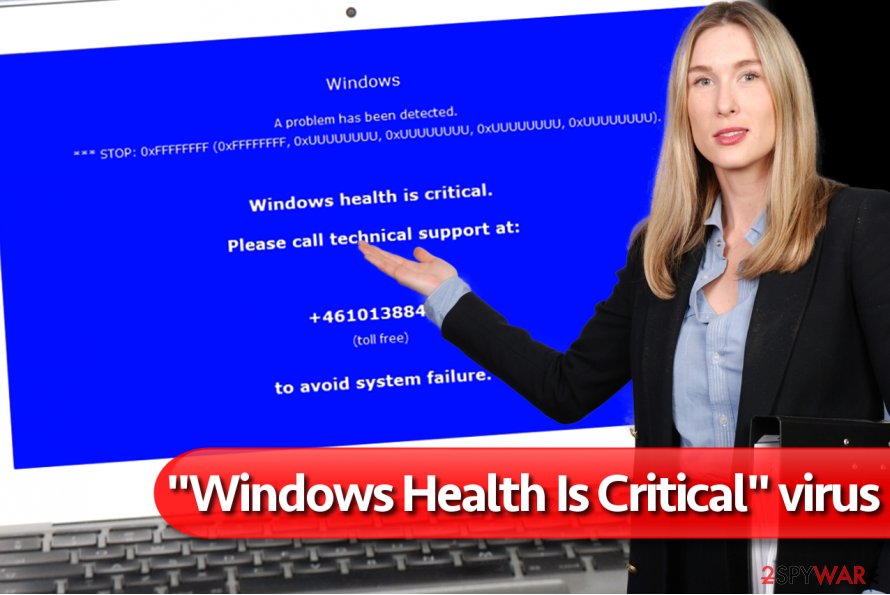“Windows Health Is Critical” virus (Tech Support Scam) - Virus Removal Instructions
“Windows Health Is Critical” virus Removal Guide
What is “Windows Health Is Critical” virus?
“Windows Health Is Critical” scam fishes for new victims

“Windows Health Is Critical” virus operates as a tech support scam malware employed to persuade users into thinking that their devices have been heavily infected with destructive threats. This scam which is identified as a malicious program is often connected to phishing websites[1]. After visiting them, netizens might be redirected to other domains which present counterfeited Windows BSOD screen messages[2].
The first indicator suggesting it is purely a scam is that genuine BSOD never opens via any web browser. So if your browser automatically opened such page or if you were forcibly redirected to one, you should take actions to remove “Windows Health Is Critical” malware from your computer.
The deceptive message says that a problem has been detected, and lists a line of suspiciously-looking codes that ostensibly reveal what errors were detected. The following lines state that Windows health is critical and that the user should call technical support at +46101388486.
You should NEVER call numbers provided on vague websites that claim you must get in touch with technical support because of some error or problem “detected” on your PC. As a matter of fact, Microsoft will not alarm you with such alerts or messages. Note that original notifications never indicate a phone number or email address.
Thus, getting such and similar messages simply shows that you need to remove “Windows Health Is Critical” tech support scam malware from your PC. We honestly recommend you to use anti-spyware or anti-malware for that (for instance, FortectIntego or Malwarebytes) because it will be much easier to identify and remove the scam program from your PC.

Scammers that try to trick inexperienced PC users to call them are willing to swindle money from them. There is a traditional scenario that tech support scammers swear by:
- Trick the victim to believe that he/she is speaking with IT professionals by commanding him/her to complete series of tasks, such as launch Run prompt, go to certain folders or panels, delete random files and so on.
- The scammers seek to gain victim’s trust so that he/she would continue listening to further demands.
- Once the scammers trick the victim into thinking that he/she is talking with experienced computer technicians, they suggest buying a particular software pack for an incredible price, for instance, $299 per year. Such software pack typically consists of a legitimate anti-malware program and several free software pieces such as Adblocker.
- The scammers may also ask the victim to provide them remote access to the “compromised” computer via legitimate programs like TeamViewer or LogMeIn. Remember – legitimate companies like Microsoft would NEVER do that! Hang up, because if you provided scammers access to your PC, they could plant malware[3] on it.
Tricks facilitating the distribution of tech support scams
You can accidentally end up on such phishing websites by browsing the Internet via bogus search engines, clicking on a deceptive ad brought by adware, or simply by having a tech support malware on your system.
Such software can be placed on your computer during installation of another controversial program, so make sure you always choose Custom or Advanced settings when installing new programs. This will allow you to see and drop off all bundled software.
Contrary to popular belief, Standard, Default, Basic and every other software installation method marked as “recommended” isn’t necessarily the most safest option to install your desired program. In fact, these settings are designed to get your permission to install suggested programs without letting you know – the statements granting your permission to do it are hidden or provided in fine print below them.
Eliminate “Windows Health Is Critical” infection
Take matters into your hands and remove “Windows Health Is Critical” virus right now so that it couldn’t send these deceptive pop-ups for you anymore. We highly suggest that you use anti-malware software for “Windows Health Is Critical” removal because trying to delete the described malware can be tricky.
In order to delete the malware, follow these instructions:
Getting rid of “Windows Health Is Critical” virus. Follow these steps
Manual removal using Safe Mode
The easiest way to remove the virus is to boot your PC into Safe Mode with Networking, download an anti-malware program, and let it perform a system scan.
Important! →
Manual removal guide might be too complicated for regular computer users. It requires advanced IT knowledge to be performed correctly (if vital system files are removed or damaged, it might result in full Windows compromise), and it also might take hours to complete. Therefore, we highly advise using the automatic method provided above instead.
Step 1. Access Safe Mode with Networking
Manual malware removal should be best performed in the Safe Mode environment.
Windows 7 / Vista / XP
- Click Start > Shutdown > Restart > OK.
- When your computer becomes active, start pressing F8 button (if that does not work, try F2, F12, Del, etc. – it all depends on your motherboard model) multiple times until you see the Advanced Boot Options window.
- Select Safe Mode with Networking from the list.

Windows 10 / Windows 8
- Right-click on Start button and select Settings.

- Scroll down to pick Update & Security.

- On the left side of the window, pick Recovery.
- Now scroll down to find Advanced Startup section.
- Click Restart now.

- Select Troubleshoot.

- Go to Advanced options.

- Select Startup Settings.

- Press Restart.
- Now press 5 or click 5) Enable Safe Mode with Networking.

Step 2. Shut down suspicious processes
Windows Task Manager is a useful tool that shows all the processes running in the background. If malware is running a process, you need to shut it down:
- Press Ctrl + Shift + Esc on your keyboard to open Windows Task Manager.
- Click on More details.

- Scroll down to Background processes section, and look for anything suspicious.
- Right-click and select Open file location.

- Go back to the process, right-click and pick End Task.

- Delete the contents of the malicious folder.
Step 3. Check program Startup
- Press Ctrl + Shift + Esc on your keyboard to open Windows Task Manager.
- Go to Startup tab.
- Right-click on the suspicious program and pick Disable.

Step 4. Delete virus files
Malware-related files can be found in various places within your computer. Here are instructions that could help you find them:
- Type in Disk Cleanup in Windows search and press Enter.

- Select the drive you want to clean (C: is your main drive by default and is likely to be the one that has malicious files in).
- Scroll through the Files to delete list and select the following:
Temporary Internet Files
Downloads
Recycle Bin
Temporary files - Pick Clean up system files.

- You can also look for other malicious files hidden in the following folders (type these entries in Windows Search and press Enter):
%AppData%
%LocalAppData%
%ProgramData%
%WinDir%
After you are finished, reboot the PC in normal mode.
Finally, you should always think about the protection of crypto-ransomwares. In order to protect your computer from “Windows Health Is Critical” and other ransomwares, use a reputable anti-spyware, such as FortectIntego, SpyHunter 5Combo Cleaner or Malwarebytes
How to prevent from getting malware
Do not let government spy on you
The government has many issues in regards to tracking users' data and spying on citizens, so you should take this into consideration and learn more about shady information gathering practices. Avoid any unwanted government tracking or spying by going totally anonymous on the internet.
You can choose a different location when you go online and access any material you want without particular content restrictions. You can easily enjoy internet connection without any risks of being hacked by using Private Internet Access VPN.
Control the information that can be accessed by government any other unwanted party and surf online without being spied on. Even if you are not involved in illegal activities or trust your selection of services, platforms, be suspicious for your own security and take precautionary measures by using the VPN service.
Backup files for the later use, in case of the malware attack
Computer users can suffer from data losses due to cyber infections or their own faulty doings. Ransomware can encrypt and hold files hostage, while unforeseen power cuts might cause a loss of important documents. If you have proper up-to-date backups, you can easily recover after such an incident and get back to work. It is also equally important to update backups on a regular basis so that the newest information remains intact – you can set this process to be performed automatically.
When you have the previous version of every important document or project you can avoid frustration and breakdowns. It comes in handy when malware strikes out of nowhere. Use Data Recovery Pro for the data restoration process.
- ^ Liam Tung. Microsoft: Beware this fake Windows BSOD from tech support scammers' malware. ZDNet. Technology News, Analysis, Comments and Product Reviews.
- ^ Blue Screen of Death. Wikipedia. The Free Encyclopedia.
- ^ Lucia Danes. Computerviren und Schadsoftware. DieViren. Virus Removal Tutorials.














